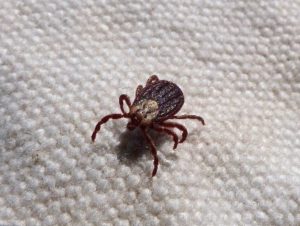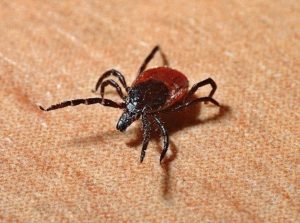Spring is right around the corner—the time of year that symbolizes renewal in the form of budding trees and flowers, warmer weather and outdoor activities. It’s what we’ve been waiting for to awaken us from the winter doldrums. And just like you, your dog welcomes the new season and looks forward to more frequent trips outside, outdoor playtime and longer walks. This increased time outside, though, can lead to trouble for Fido – and you – if you don’t know how to prevent fleas and ticks from latching on and spoiling the fun. Here’s what you need to know about fleas and ticks, and what you can do to help keep them at bay.
Common Ticks
There are two types of ticks most common to the St. Louis area. Both types are carriers of serious diseases that can create potential health threats to you and Fido. Knowing how to identify these ticks, understanding the risks they pose and the signs to look for can help protect you and your dog from a potentially life-threatening illness.
Dog Tick

Dog ticks are brownish-white in color with gray markings and flat, oval-shaped bodies. Their size is about 5/8” long by 3/8” wide once they feed. Dog ticks can transmit Rocky Mountain spotted fever and can cause paralysis in hosts.
Black-legged Tick (Deer Tick)

The black-legged, or deer, tick is dark-reddish brown in color with darker legs. While these ticks prefer to feed on white-tailed deer, they will attach themselves to other hosts including dogs and humans. Female deer ticks are about 1/8” long, while males are about 1/16” long. The deer tick can cause Lyme disease.
What to Look For:
There are several signs to look for to see if your dog may have picked up a tick. They include:
• A noticeable bump on your dog’s skin while petting them
• Unexplained scabs – Fido may excessively lick or nip at a spot where a tick has embedded itself
• Head shaking – dogs will shake their heads frequently if a tick burrows into its ear canal
• Fever – weakness, loss of appetite, shivering and abnormal panting are all signs your dog may have a mild- or high-grade fever
Signs of tick paralysis include:
• Vomiting or regurgitating
• Unsteadiness
• A fast heart rate or rhythm
• Difficulty eating
• Excessive drooling
• Dilated pupils
• Weakness, especially in the hind legs
• Poor to complete loss of reflexes
• Partial or complete loss of muscle movement
Common Fleas

In St. Louis, the most common type of flea is the cat flea. But don’t be fooled by the name – these fleas aren’t that picky. They also like dogs, raccoons, and foxes. Fleas can’t fly, but they can jump up to 8”! They have flat, thin bodies covered with spines that help them move through the fur of their host.
Ask anyone who’s dealt with a flea infestation and they’ll tell you it’s no fun; fleas can be very difficult to get rid of because they multiply quickly. Fleas can stay on a dog for up to three months. It will lay its eggs on your dog, and those eggs can fall off and land on your rug. The eggs hatch into larvae within two to 12 days, and the larvae can migrate up to six feet. Fleas can cause allergic reactions and can also be intermediate hosts for tapeworms that can potentially infect you and your dog. They can also cause anemia, dermatitis and other illnesses and diseases.
What to Look For:
If Fido is scratching or licking excessively, he may be telling you that he has fleas. Other signs may include:
• Head shaking and ear scratching
• Redness, blood or dirt in the ears
• Red, bumpy skin on Fido’s belly, groin area or near the base of his tail
• Hair loss in areas of excessive scratching
• Black spots and scabbing on the skin
If an infestation is severe, you’ll be able to see the fleas jumping and moving on Fido’s fur.
Prevention
The thought of fleas and ticks is enough to make your (and Fido’s) skin crawl, but there are some precautions you can take to help protect against them.
• Parasites like fleas and ticks like to gather in tall grass, so avoid walking your dog or letting him roam in or near tall grasses, overgrown fields, thick brush or heavily wooded areas
• Give Fido a bath if you think he may have gotten into any areas of tall grass, thick brush or dense woods
• Wash Fido’s bedding and soft toys
• Vacuum frequently
Don’t forget about your yard!
Your yard can be a great place for Fido to run and play. It can also attract fleas and ticks if not properly maintained.
• Keep the grass mowed and well-trimmed
• Prune shrubs and other vegetation around the yard
• Remove decaying leaves or brush and large piles of debris; rake excess wood, brush or leaves
• Don’t leave dog or cat food outside – it can attract other animals like raccoons and opossums that can bring fleas and ticks into the yard
In addition to these tips, remember to talk to your veterinarian about flea and tick prevention treatment for your dog. There are several options including collars, topical treatments, and chewable tablets. Your veterinarian can help you decide which treatment option is best.
Staying vigilant about flea and tick prevention can help ensure you and Fido enjoy the outdoors this spring and beyond.
If your dog is exhibiting any of the signs or symptoms listed above, please contact your veterinarian.

